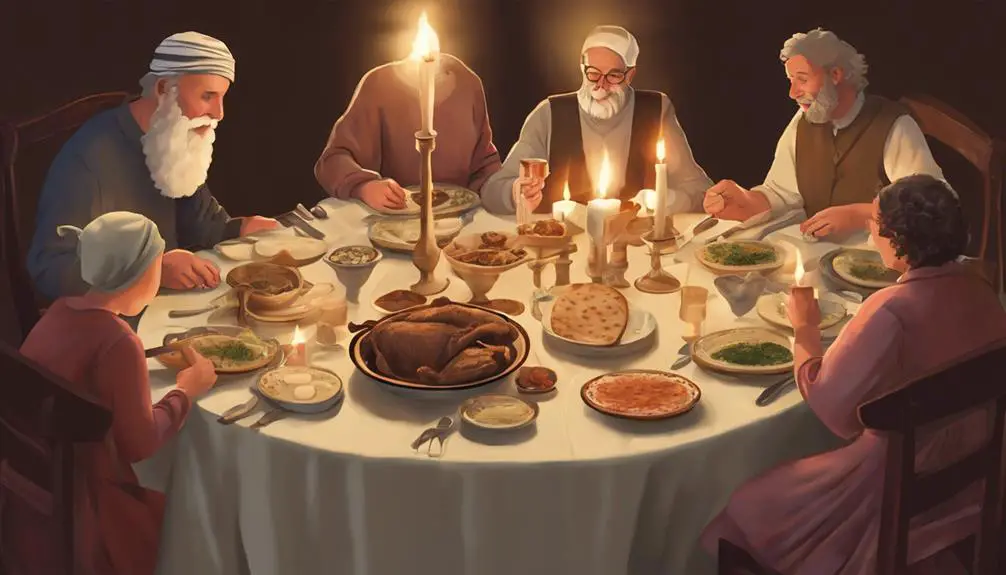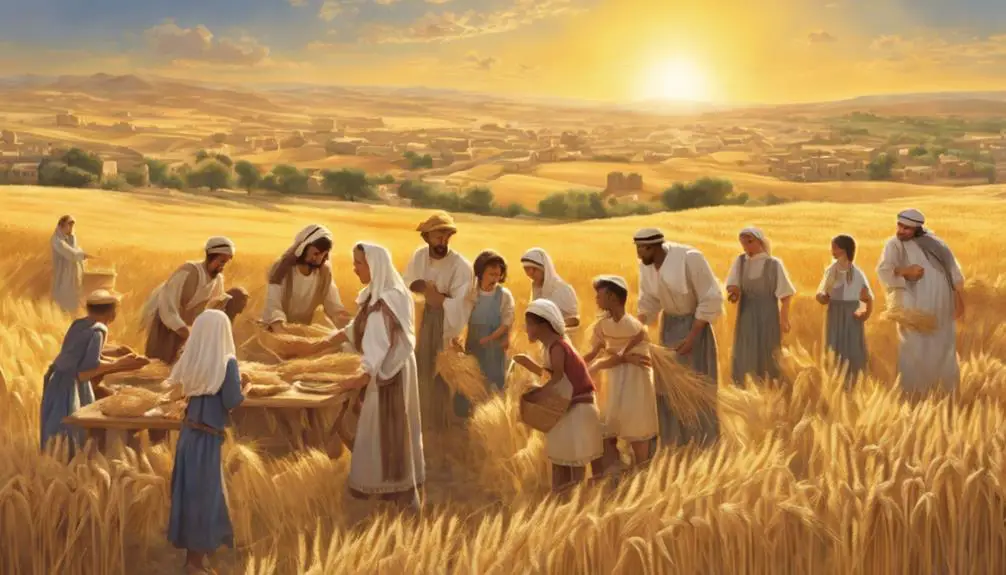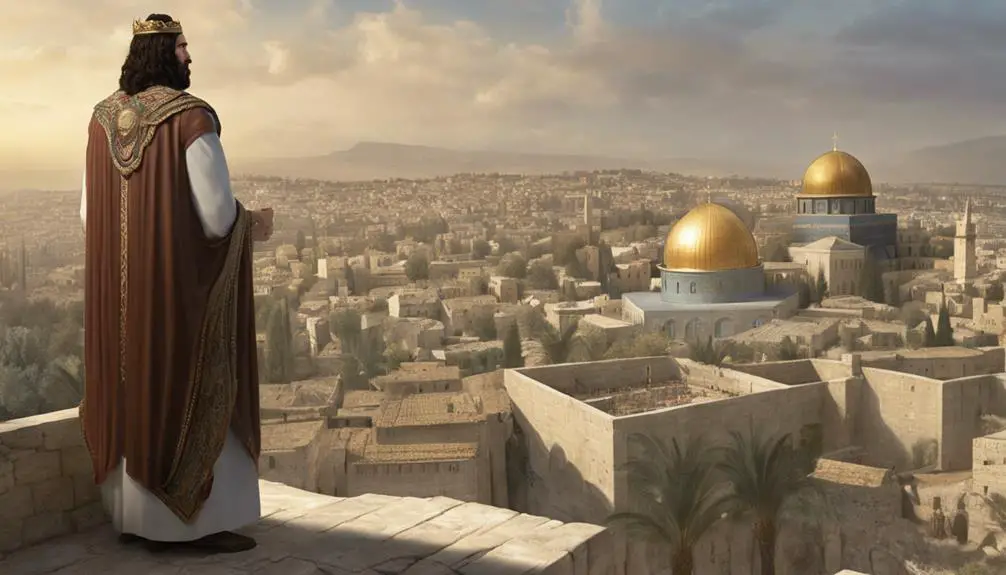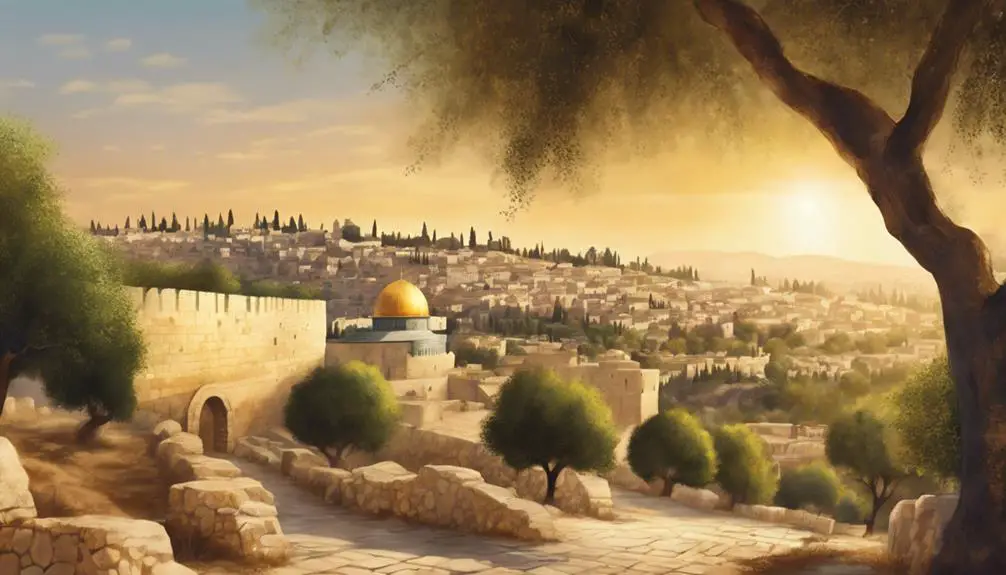Hidden in biblical narratives, the number 15 unveils deep spiritual meanings and connections, inviting exploration into its symbolic significance.

15 Means in the Bible
In the tapestry of biblical narratives, the number 15 serves as a subtle yet significant thread, weaving through various traditions and stories. You'll find that its appearance is not just a coincidence but carries deep symbolic meaning, from marking moments of transition and celebration to symbolizing divine mercy and covenant.
As we explore the instances of 15 in contexts like the Passover observance, Solomon's architectural undertakings, and the prophetic significance of Hezekiah's extended life, you're invited to uncover how these narratives interlink and what they reveal about the broader spiritual landscape.
This journey promises to offer insights into the intricate ways numbers function within biblical texts, potentially transforming your understanding of these ancient stories.
Key Takeaways
- The number 15 can symbolize divine intervention, as seen in Hezekiah's life extension.
- It may represent aspects of rituals and covenants, echoing in Passover observances.
- The figure could underline transformation and renewal, highlighted by Sarai's identity change.
- 15 might signify the depth of divine-human interactions, including communication and promises.
The Genesis of 15

Analyzing Genesis 15, we observe a pivotal moment where God formalizes His covenant with Abram, marking a foundational episode in the narrative of divine promises and human faith. This covenant not only alters the trajectory of Abram's life but also sets a precedent for the unfolding story of a chosen people. You'll notice that the ceremony involves specific rituals and promises, underscoring the solemnity and significance of the event.
Abram's covenant with God is rich in symbolism and meaning, laying the groundwork for future interactions between the divine and His people. It's here that the depth of Abram's faith is tested and affirmed, setting him apart as a key figure in biblical history. This covenant isn't merely a contract; it's a profound expression of commitment and trust between God and man.
Intriguingly, this segment of Genesis also sets the stage for Sarai's name change, an event that, while not occurring within this chapter, is intricately connected to the covenant's implications. The name change signifies a transformation in identity and destiny, not just for Sarai but for the nation that would emerge from her lineage. Through these acts, the narrative conveys themes of faith, promise, and the power of divine intervention, establishing a pattern of God's enduring relationship with His people.
15 in Passover Observance

Reflecting on the foundational covenants of the Bible, such as the one between God and Abram, it's clear how these early narratives set the stage for later religious observances, including the Passover. The Passover observance, deeply rooted in biblical history, is rich with symbols and rituals that echo the Israelites' experiences in Egypt and their journey to freedom.
Among these, the bitter herbs and Seder plate elements stand out for their profound symbolism. The bitter herbs, typically horseradish or romaine lettuce, symbolize the bitterness of slavery that the Israelites endured in Egypt. This act of consumption isn't just a reminder of the past; it's a visceral, physical connection to the experiences of the ancestors, designed to evoke empathy and reflection in the participants.
Meanwhile, the Seder plate is a tableau of symbolism. Each element—the shank bone, egg, charoset, karpas, and bitter herbs—represents a different aspect of the Passover story, from sacrifice to the mortar used by enslaved Israelites. These elements serve as a means to discuss and transmit the values and lessons of the Exodus story, emphasizing themes of freedom, resilience, and divine deliverance.
Solomon's Architectural Symbolism

In the realm of biblical architecture, King Solomon's Temple stands as a monumental epitome of spiritual and national identity, intricately weaving symbolism into its very structure to reflect the covenantal relationship between God and Israel. This symbolism, deeply rooted in Solomon's wisdom, is most evident in the Temple furnishings, each piece meticulously designed to carry profound theological significance:
- The Ark of the Covenant: Positioned in the Most Holy Place, it symbolized God's presence among His people, embodying the heart of the covenant.
- The Bronze Altar: Here, sacrifices were made, representing atonement and reconciliation with God. Its prominent placement underscored the centrality of repentance.
- The Menorah (Golden Lampstand): This illuminated the Temple's interior, symbolizing God's light guiding Israel in darkness, reflecting Solomon's wisdom in understanding the need for divine guidance.
- The Table of Showbread: Bearing twelve loaves, it represented the sustenance God provides to the twelve tribes of Israel, highlighting His continual provision.
Each piece served as a tangible reminder of the spiritual truths that underpinned Israel's faith, demonstrating Solomon's profound understanding of symbolism and its power to communicate divine principles.
Feast of Unleavened Bread

The Feast of Unleavened Bread, a pivotal seven-day celebration in the Jewish liturgical calendar, commemorates Israel's hasty departure from Egypt, underscoring the urgency and divine intervention in their exodus. This observance not only memorializes a historic event but also integrates profound spiritual and ethical teachings, relevant through the ages.
Modern interpretations of this feast offer a rich tapestry of meanings, extending its significance beyond its historical origins. Scholars argue that the abstention from leavened bread serves as a metaphor for purging moral and spiritual corruption, inviting adherents to reflect on personal renewal and liberation from oppressive behaviors or thoughts. This connection between dietary regulations and ethical introspection demonstrates the dynamic way religious practices can adapt to contemporary spiritual needs while maintaining fidelity to their roots.
Dietary regulations during this feast, specifically the elimination of leaven (yeast) from the diet, underscore a broader theme of purity and simplicity. This practice encourages participants to consider the essential aspects of life, stripping away superficialities to focus on what truly sustains. Thus, the Feast of Unleavened Bread remains a powerful synthesis of historical remembrance, spiritual purification, and ethical reflection, resonating deeply within the Jewish tradition and beyond.
Hezekiah's Extended Life

King Hezekiah's life, extended by 15 years through divine intervention, presents a compelling narrative that explores themes of faith, prayer, and the interplay between divine will and human agency. This miraculous recovery, prompted by prophetic intervention, underscores the profound impact of divine mercy in response to human petition. The episode illuminates several key aspects:
- The Power of Prayer: Hezekiah's earnest prayer for healing demonstrates the potency of sincere supplication and its potential to alter divine decisions.
- Prophetic Role: The prophet Isaiah's involvement highlights the conduit through which divine messages and interventions are often dispensed, reinforcing the significance of prophetic figures in biblical narratives.
- Divine Will vs. Human Agency: The extension of Hezekiah's life raises intricate questions about predestination and free will, particularly how human actions can seemingly influence divine plans.
- Signs and Wonders: The backward movement of the sun's shadow as a sign of this event not only serves as proof of the miraculous recovery but also emphasizes the omnipotence of God and His ability to manipulate the natural order.
This episode, rich in theological and philosophical implications, invites readers to ponder the dynamics of faith, divine responsiveness, and the mysterious ways in which God interacts with His creation.
Ezra's Spiritual Journey

Reflecting on Hezekiah's narrative of divine intervention and human petition, we now turn our attention to Ezra's spiritual journey, marking a profound exploration of faith, law, and personal transformation within the biblical context. As a scribe and a priest, Ezra's commitment to Torah study and the spiritual revitalization of the Jewish people post-exile underscore his pivotal role in shaping the religious identity of Israel.
Ezra's reforms represent a deliberate effort to realign the community with the covenantal teachings of the Torah, emphasizing not just the letter of the law but its spirit. He didn't merely study the Torah; he lived it, embodying the principles he sought to instill in the people. Through public readings, interpretations, and enactments of the law, Ezra facilitated a communal reawakening to the sacred texts, fostering a collective sense of identity, purpose, and devotion.
His journey underscores the power of dedicated Torah study as a means of personal and communal transformation. Ezra's life illustrates how in-depth engagement with sacred texts can catalyze significant religious and social reform. Through his example, we see the profound impact of integrating study, faith, and action in the pursuit of spiritual and communal renewal.
The Significance in Psalms

Psalms' profound influence on both individual spirituality and communal worship can't be overstated, serving as a cornerstone of biblical literature that deeply resonates with believers' experiences across generations. This collection of divine poetry plays a pivotal role in expressing the multifaceted nature of human emotion towards God, ranging from deep despair to exalted praise. It's in the Psalms that you find the heart's cries articulated in a manner that's both profoundly personal and universally relatable.
The significance of Psalms in both historical and contemporary contexts can be outlined as follows:
- Expression of the Human Condition: Psalms encapsulate a wide array of human emotions, offering solace and understanding in times of distress, and joy in moments of celebration.
- Instruction in Righteousness: Through its verses, Psalms provides guidance for righteous living and spiritual growth, encouraging a deeper reflection on one's life and actions.
- Foundation for Musical Worship: Psalms has historically served as the basis for musical worship, influencing both Jewish and Christian liturgies and inspiring countless hymns and songs.
- Theological Richness: Beyond its poetic beauty, Psalms delves into profound theological questions, exploring themes of justice, mercy, and divine sovereignty.
15 Steps to the Temple

Building on the foundation of spiritual expression found in Psalms, it's crucial to explore 'Steps to the Temple' as a metaphorical journey towards deeper religious understanding and devotion. This path isn't just a physical trek but symbolizes a believer's spiritual ascent, marked by an increasing commitment to faith and adherence to divine laws. In the Biblical context, the 'Steps to the Temple' are intertwined with temple rituals and pilgrimage routes, each step taken reflecting a stage of spiritual purification and enlightenment.
Temple rituals serve as milestones on this journey. They're not mere ceremonial acts but deeply symbolic gestures embodying repentance, gratitude, and the covenant between the divine and humanity. As you ascend each step, you're encouraged to reflect on your deeds, thoughts, and the state of your heart, aligning them with the spiritual ideals represented by the Temple.
Pilgrimage routes, on the other hand, offer a physical manifestation of this spiritual journey. Traversing these paths, often laden with challenges and moments of introspection, you're participating in a tradition that transcends generations. These routes don't just lead to a geographic location but guide you through a transformative process, culminating in the Temple, the ultimate symbol of divine presence and human devotion.
The Day of Purim

Among the myriad of Jewish holidays, the Day of Purim stands out as a vibrant celebration commemorating the deliverance of the Jewish people from imminent doom in ancient Persia, as narrated in the Book of Esther. This festivity isn't only a testament to survival but also highlights the pivotal roles played by Esther's bravery and Mordecai's loyalty. Their actions are central to the narrative, offering profound insights into the dynamics of power, faith, and destiny in Biblical times.
To understand the significance of Purim, consider the following elements:
- Esther's Bravery: Her courage to approach King Ahasuerus, despite the potential personal cost, is emblematic of self-sacrifice for the greater good.
- Mordecai's Loyalty: His unwavering loyalty not only to Esther but to their people, sets a precedent for integrity and righteousness.
- Divine Intervention: The narrative underscores the belief in divine orchestration of events, where human actions align with a higher purpose.
- Celebration of Survival: Purim embodies the triumph over adversity, encouraging joyous celebration as a means of communal and historical identity reinforcement.
Through these lenses, the Day of Purim serves as a rich, scholarly topic, reflecting on themes of bravery, loyalty, and the perennial struggle for freedom and justice.
Jubilee Year Preparations

In the biblical context, the Jubilee Year's preparations involve meticulous planning and adherence to divine commandments, reflecting a profound commitment to social equity and spiritual renewal. Central to this preparation are the principles of debt forgiveness and land restoration, which underscore the socio-economic and ethical dimensions of the Jubilee.
Debt forgiveness, in this context, isn't merely a financial act but a moral imperative aimed at rectifying inequalities and fostering a community spirit. It's a deliberate process where debts are annulled to liberate individuals from the burden of poverty and dependency, thus restoring societal balance. This practice necessitates a comprehensive understanding of community debts and a collective willingness to absolve them, underscoring the communal nature of the Jubilee Year.
Land restoration, on the other hand, involves returning land to its original owners or their descendants. This act of restitution is pivotal, as it ensures that land ownership remains equitable and reflects a divine mandate for stewardship rather than exploitation. It requires detailed record-keeping and an unwavering commitment to justice, ensuring that land rights are honored and the land's sanctity preserved.
Together, debt forgiveness and land restoration epitomize the Jubilee Year's essence, embodying a holistic approach to societal rejuvenation and spiritual revival.
Numerical Patterns in Genealogies

Shifting focus to the study of biblical genealogies reveals a fascinating exploration of numerical patterns that offer deep insights into the text's structure and the cultural significance of numbers in ancient times. These patterns aren't merely coincidental but are loaded with symbolic meanings that enrich our understanding of the biblical narrative.
- Age Symbolism: The ages at which biblical figures begat their offspring or died often carry symbolic value, providing clues to their spiritual or moral stature. For instance, the numerological analysis of Methuselah's age, the oldest person in the Bible, might represent completeness or God's patience.
- Numerological Analysis: Delving into the numbers themselves, scholars find layers of meaning. Numbers like 7, 12, and 40 frequently emerge, symbolizing perfection, government, and a period of trial, respectively.
- Structural Significance: Genealogies structured around specific numbers can indicate the author's intent to convey particular theological points, such as the 14 generations in Matthew's genealogy of Jesus, emphasizing fulfillment and messianic expectation.
- Cultural Context: Understanding the cultural significance of numbers in ancient Near Eastern societies adds depth to our interpretation, as these societies often attributed divine or mystical qualities to numbers.
In essence, a careful study of biblical genealogies through age symbolism and numerological analysis unveils a rich tapestry of meaning and intention, embedded within the very structure of the biblical text.
Harvest Celebrations

Harvest celebrations in the Bible, often steeped in rich symbolism and religious significance, provide key insights into the agricultural practices and spiritual life of ancient societies. You'll find that these events weren't merely about thanking God for the bounty of the land, but also served as a reminder of the Israelites' dependence on divine providence. Autumn rituals, such as the Feast of Tabernacles, were meticulously observed. This week-long festival, occurring at the end of the harvest season, was both a time of joyous celebration and a period for seasonal prayers, asking for rain in the upcoming year.
Embedded within these celebrations were layers of cultural and theological meanings. For example, the offering of the first fruits at the temple underscored the belief in God as the ultimate source of fertility and sustenance. Similarly, the practice of leaving gleanings for the poor reflected a social ethic that intertwined religious duty with compassion and communal responsibility.
Through these observances, you can trace a profound connection between the cycles of nature, agricultural labor, and the rhythm of religious life. The biblical narrative, in detailing these practices, highlights the interdependence of human activity and divine blessing, framing harvest time as a pivotal moment for reflection, gratitude, and communal solidarity.
King Ahaz's Reign

King Ahaz's reign, marked by significant religious and political upheavals, starkly contrasts the spiritual unity observed during the harvest celebrations previously discussed. His leadership is a pivotal point in Judaic history, characterized by a shift towards idolatry practices and strategic, albeit controversial, alliances.
You'll find that Ahaz's tenure is dissected into various aspects:
- Ahaz's Alliances: He sought the support of Assyria to fend off threats from Israel and Aram. This maneuver, while politically savvy, led to Assyria's increased influence over Judah, fundamentally altering its geopolitical landscape.
- Idolatry Practices: Ahaz introduced and encouraged the worship of Baal, significantly diverging from the monotheistic worship of Yahweh. This shift not only alienated a portion of his subjects but also instigated a cultural and religious transformation within the kingdom.
- Economic Repercussions: The tribute paid to Assyria strained Judah's economy, leading to widespread discontent among the populace. This financial burden was a direct result of Ahaz's foreign policy decisions.
- Cultural Shifts: The introduction of Assyrian gods and the construction of altars in their honor marked a departure from traditional Judaic practices, reflecting Ahaz's attempts to align more closely with Assyrian culture and religion.
Analyzing Ahaz's reign offers insight into the complexities of leadership during a period of tumultuous change.
The Wall of Jerusalem

Exploring the Wall of Jerusalem further illuminates the socio-political landscape that Ahaz's decisions impacted, revealing its significant role in the kingdom's defense and identity. The construction and subsequent repair of Jerusalem's wall under Nehemiah's leadership, after the Babylonian exile, underscore its vital importance not just as a physical barrier but as a symbol of restoration and unity for the Israelites. Nehemiah's efforts to rebuild the wall, amidst considerable opposition, demonstrate a strategic endeavor to re-establish Jerusalem's sovereignty and the people's morale. This initiative wasn't merely about bricks and mortar; it was a rallying point for a community seeking to reclaim its identity and autonomy after years of displacement.
The narrative around the wall transcends its function as a defensive structure. It becomes a testament to the resilience and faith of the Jewish people. Nehemiah's leadership, characterized by determination and faith, was pivotal in mobilizing the returnees from the Babylonian exile. His ability to inspire and organize the people for the task of rebuilding the wall, despite the enormity of the challenge, illustrates the critical interplay between leadership, communal spirit, and faith in achieving what seemed an insurmountable task.
Spiritual Rest and Deliverance

In the biblical narrative, spiritual rest and deliverance emerge as foundational concepts, central to understanding the transformative journey of the Israelites from despair to hope. These themes are intricately woven into the fabric of scripture, offering you a lens through which to view the significance of divine intervention and the establishment of practices aimed at fostering spiritual wellness and liberation.
- Quiet waters as a metaphor for spiritual peace: The imagery of being led beside quiet waters in Psalms reflects the profound sense of spiritual rest and rejuvenation that comes from divine guidance and protection. This symbolizes a state of tranquility and safety, essential for spiritual growth and recovery.
- Sabbath observance as a means of deliverance: The institution of the Sabbath is a testament to the importance of rest in God's design for humanity. It serves as a weekly reminder of liberation from bondage, both physically in the context of the Exodus and spiritually from the toils of life.
- The role of faith in experiencing rest and deliverance: Trusting in God's promises and faithfulness is portrayed as a prerequisite for entering into His rest, highlighting the relational aspect of deliverance.
- The collective experience of rest: Scripture often speaks of rest and deliverance in a communal context, suggesting that these blessings are meant to be experienced collectively, within the community of believers, reinforcing the notion of shared spiritual journeys.
Frequently Asked Questions
How Does the Concept of 'Means' Relate to the Practice of Fasting in the Bible?
In discussing fasting and its significance, it's crucial to understand how fasting serves as a means to deepen one's spiritual discipline.
By engaging in fasting, you're not just abstaining from food for health or dietary reasons; you're tapping into fasting benefits that enhance your spiritual journey.
This practice isn't merely about physical discipline; it's a deliberate choice to focus more profoundly on your spiritual growth and connection.
In What Ways Did Jesus Redefine or Expand Upon the Idea of 'Means' in His Teachings?
Jesus expanded upon traditional concepts by introducing divine paradoxes and showcasing love as the ultimate manifestation of one's actions. He transcended mere ritualistic practices, advocating for a deeper, more personal connection with the divine.
Through parables and teachings, He emphasized love's central role, urging followers to see beyond literal interpretations. His approach redefined religious practices, making love and compassion the core means of connecting with and understanding the divine essence.
Are There Any Specific Examples of Women Utilizing 'Means' for Spiritual or Practical Purposes in the New Testament?
You're looking for examples where women challenge societal norms through their actions for spiritual or practical purposes in the New Testament.
Consider the story of Mary Magdalene, who broke societal norms by becoming one of Jesus' most devoted followers.
Also, think about the Samaritan woman at the well, who spread Jesus' message, defying gender and ethnic expectations.
These instances highlight women's roles in navigating and redefining their means within their cultural and religious context.
How Is the Principle of 'Means' Reflected in the Parables of Jesus?
In analyzing Jesus' parables, you'll find that the principle of 'means' is central to their interpretation. These stories aren't just narratives; they're layered with moral implications, urging you to reflect on the means used for spiritual growth or societal impact.
Through parables, Jesus illustrated how different means—whether they be actions, decisions, or resources—can profoundly influence outcomes, emphasizing the importance of choosing wisely to achieve desired moral and spiritual ends.
Can the Idea of 'Means' Be Connected to the Concept of Stewardship and Caring for the Earth in Biblical Texts?
Absolutely, you can link stewardship and caring for the Earth in biblical texts to broader principles, including environmental responsibility and sustainable living. These concepts underscore the responsibility entrusted to humanity to preserve and protect the planet.
Biblical teachings encourage stewardship as a means of honoring creation, promoting sustainable practices, and ensuring resources are managed wisely. This perspective is critical for fostering a healthier relationship with our environment, aligning with both spiritual and ecological principles.
Conclusion
In analyzing the biblical significance of the number 15, it's evident that it's more than a mere numeral. You've seen its symbolic relevance across various contexts—from Passover observances to architectural symbolism in Solomon's era, and significant events in the lives of figures like Hezekiah.
It encapsulates themes of deliverance, spiritual rest, and divine intervention within the biblical narrative. This multifaceted significance underscores the intricate tapestry of symbolism that the Bible weaves, revealing deeper layers of spiritual and historical meaning.



Sign up